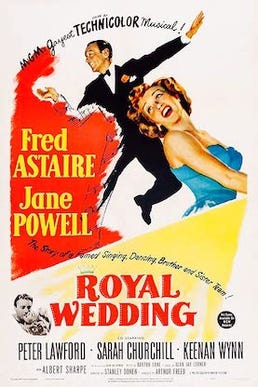Think back to years ago, before war for altruism became official U.S. foreign policy, before inflation and the Biden presidency—before pandemic panic and lockdown—before Trump, 2008’s financial crash, Obama and Black Tuesday. Royal Wedding with Jane Powell and Fred Astaire takes you to a lovelier time and place. Lightness makes the 1951 movie a treasure in time.
Colored in gray, red and gold, splashed with song, dance and snappy but subtle humor and pegged to the title’s impending wedding between an English prince named Philip and his bride, Elizabeth, the queen of England, this 93-minute MGM musical marks a moment in Fred Astaire’s exemplary artistic career when the then-51-year-old actor and dancer depicted a scenario similar to his own life. Dancing for hire with a sister in London, charming London audiences and enchanting its aristocrats forms a general basis for Royal Wedding, which brushes itself with nonchalance and a touch of Adele Astaire’s arch and knowing sexual liberation. …
Keep reading with a 7-day free trial
Subscribe to Autonomia to keep reading this post and get 7 days of free access to the full post archives.




